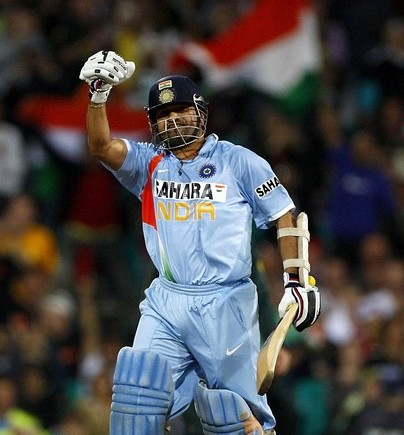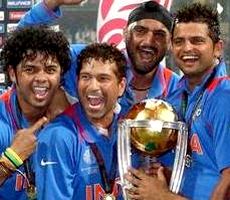|

Rohit Sharma's 209 capped a series that had everything for batsmen and nothing for bowlers
© BCCI
|
|
Enlarge
|
|
|
|
"Welcome to F50. It's like a normal T20 game, only it's played over
seven hours instead of three. And to compensate for biting a bigger
chunk out of your day, there will be one less deep fielder to prevent
boundaries. The entertainment doesn't stop, all day long." In a few
years, one-day international cricket might well be sold like that, along
with visuals from the ODI series between India and Australia to make
for irresistible advertising.
For a series written off as meaningless even before it began, India and
Australia may just have provided a glimpse of the future. Of what
one-day cricket might become, especially on the subcontinent, with dead
pitches, fast outfields, moderately sized boundaries and dew.
Australia and India scored 3596 runs in 11 innings over six games. Had the Ranchi ODI not been washed out halfway, and the Cuttack ODI been played, this series would have comfortably breached the 4000 mark, which has never happened before.(CHECK THE STASTICS BELOW)
Fours. Sixes. Hundreds. A double-hundred. Take your pick. Feel like it's
becoming stick cricket? Well, you asked for it when you started feeling
"bored" during an ODI. There used to be something loosely called the
middle overs, when batting teams tried to build by taking singles and
twos and fielding sides tried to contain by restricting boundaries. Fans
apparently found the middle overs too tedious, especially with the rise
of T20 cricket.
To make ODIs interesting, administrators injected more "excitement".
Now, with only four men allowed in the deep, a boundary is never too
hard to hit and there are no middle overs. There are only boundaries.
There is only excitement. The assumption, of course, is that more
excitement will make ODIs more interesting.
An ESPNcricinfo correspondent who covered the Bangalore ODI
did not come across anyone who appeared to negate that assumption, as
India racked up 383 in 50 overs. People screamed and danced at each of
the 30 fours and 19 sixes India hit. Most will remember it as the time
they watched Rohit Sharma hit only the third double-hundred in an ODI.
For many, it was an unforgettable evening, one of the best they have
ever had. Stick cricket? Not for them. Reminiscent of an IPL evening's
entertainment? Yes, with nationalistic fervour thrown in.
This is to take nothing away from Rohit's achievement, or Virat Kohli's
or George Bailey's. Rohit, or any of the other batsmen, did not ask for
the game to discriminate further against bowlers. Like some batsmen, he
can't even be accused of slogging wildly. He largely played smooth,
orthodox cricket strokes. Which is what is scary. The fact that he did
not seem to take too many risks, and yet managed to compile 209 off 158,
leaves one with plenty to ponder about the future of the game.
The fact that India did not seem to take too many risks, and yet chased 350-plus totals twice in the series, and that in one
of them they sealed the match inside 44 overs for the loss of just one
wicket, just adds to the horror. Australia were 211 for 8 in Bangalore,
and still scored so rapidly that for some time, there was a realistic
chance of 384 being overtaken.
A line of argument is that the bowling in the series was so bad even
five deep fielders would not have made a difference. An example is
Ishant Sharma's 30-run over
to James Faulkner in Mohali. MS Dhoni put three of the permissible four
men on the leg-side boundary, but Faulkner's sixes cleared them
comfortably. Was it just plain bad bowling and good batting?
The fear of getting hit, of having reduced protection on the boundary,
and of having no margin for error, could well have led bowlers to lose
lines and lengths more frequently. You can try bowling outside off stump
to a packed off-side field, but what if the batsman takes the ball from
there and hits it to deep midwicket? The new restrictions mean the
captain might not be able to place anyone in that region at that moment.
The batsman now knows one of either mid-off or mid-on will be in the
circle. If not, then both third man and fine leg will be. On quick
Indian outfields, a healthy edge will get you four more often than not.
There is a smaller risk of being caught in the deep. With the kind of
monster bats in use, an attempt to clear mid-off could easily go for
six. An attempt to hit a six might clear the ground.
The one-day format has suffered so many tweaks it has become a hideous
degenerate in some conditions, almost an extended form of T20. This
series has shown us the kind of excesses the latest mutation can cause.
Australia in India 2013-14 may well be remembered for introducing the
world to F50 unless something is done about it.


















